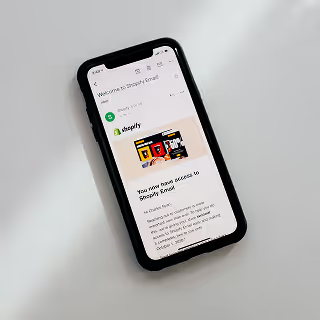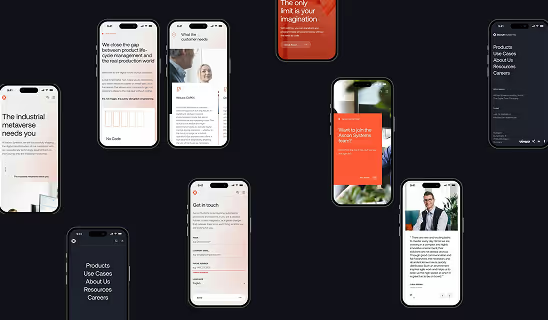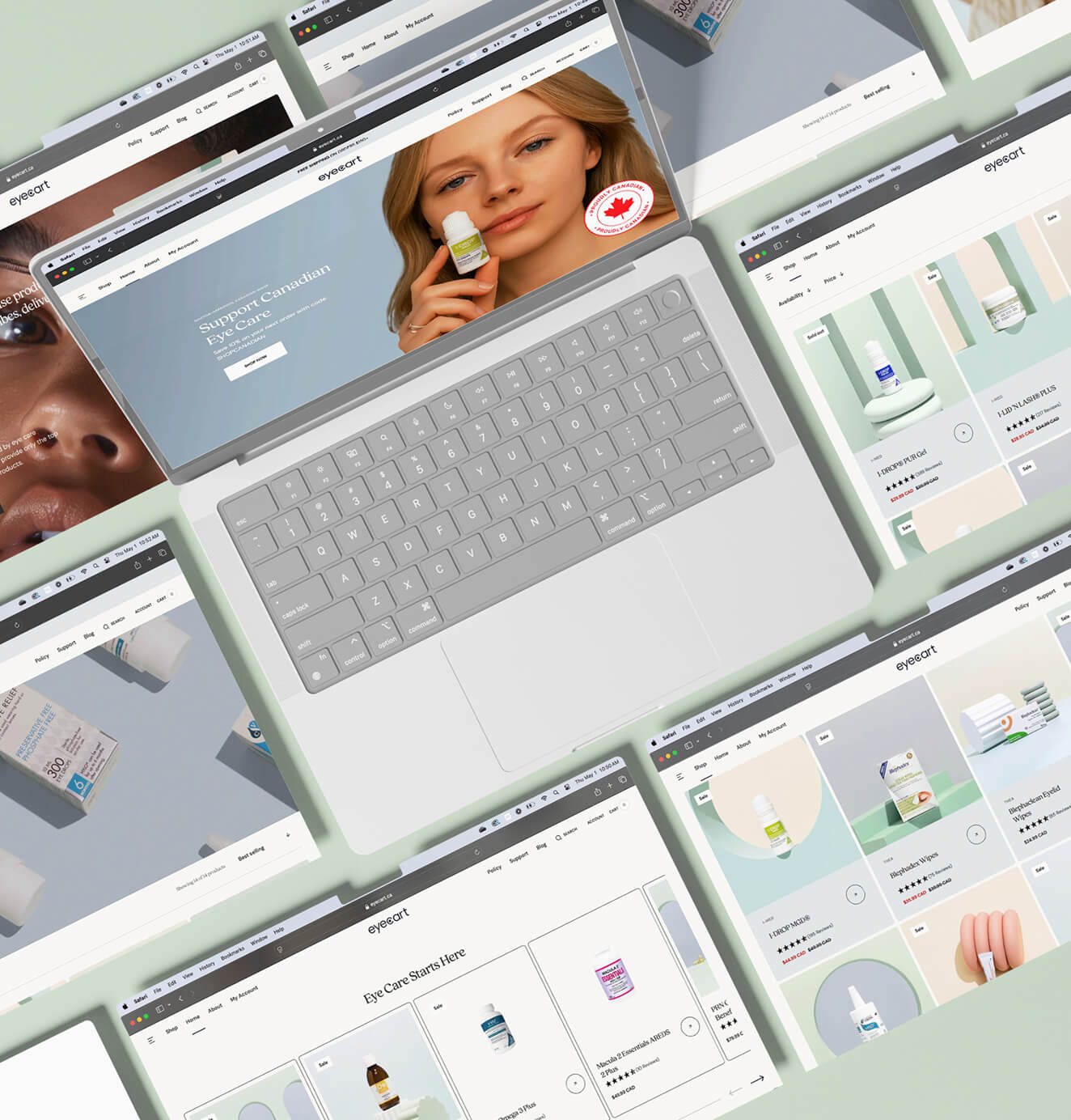How to Build a SaaS Website
03/04/2025
Web Design / Software Development / Technology
A well-optimized SaaS website is crucial for attracting users, showcasing value, and driving conversions—this guide walks you through the key steps to build one effectively.

Are you ready to dive into the exhilarating world of SaaS website creation? In this no-nonsense guide, we're stripping away the fluff and getting down to the brass tacks of building a SaaS website that doesn't just float in the digital ocean but makes some serious waves. First off, let's get our heads around what SaaS (Software as a Service) really is. Think of it as the rockstar of the software world – it's not just a product, it's a service. And in this service-driven digital age, your website isn't just a billboard; it's the front door, the living room, and the kitchen of your business where all the magic happens. So, why is a kick-ass SaaS website crucial? Because in the realm of SaaS, your website is more than just a digital presence. It's your pitch, your platform, your powerhouse – all rolled into one. It's where first impressions are made, deals are sealed, and user loyalty is forged. In the upcoming sections, we're not just talking theory. We're diving into the nitty-gritty of understanding your audience, choosing tech that doesn’t just tick boxes but blows minds, designing a UI that’s as intuitive as it is innovative, and launching a site that not only functions flawlessly but also tells a story. Whether you're a coding guru or just starting out, this guide is your roadmap through the wild terrain of SaaS website creation. So, buckle up, get your creative juices flowing, and let's embark on this journey to build a SaaS website that stands out in the digital cosmos. Let the adventure begin!
.png)


Understanding Your Audience and Market



The Art of Knowing Your Crowd
Before you even think about code, colors, or catchy taglines, there's something you've got to nail down first – who are you building this digital empire for?
Understanding your audience isn't just about demographics and data points; it's about getting into their heads, knowing their pains, pleasures, and what makes them tick.
Are they tech-savvy entrepreneurs?
Time-strapped small business owners?
Or maybe they're the creative mavericks looking for a tool that speaks their language.
Whoever they are, your website needs to resonate with them on a level that's more personal than business.
Spy Game: Analyzing Competitors and Market Demands
Next up, it's time to play a little game of digital espionage.
Your competitors – love them or hate them, they've got lessons to teach. What are they doing right?
Where are they dropping the ball? This isn't about copying homework; it's about understanding the playing field.
Dive into their features, user experience, and customer feedback. It's all valuable intel for your mission.
But hey, don't just stop there.
The market is an ever-evolving beast.
What's in demand today might be old news tomorrow.
Keep your finger on the pulse of emerging trends, technologies, and user expectations.
Remember, in the world of SaaS, staying ahead isn't just an advantage; it's a necessity.
Tailoring Your Website to Meet Specific User Needs
Armed with knowledge about your audience and the market, it's time to tailor your website like a bespoke suit.
Every element, from navigation to content, needs to speak directly to your audience's needs and desires.
This is where you turn 'visitors' into 'users' and 'users' into 'evangelists'.
Think user-centric.
Is your audience looking for lightning-fast solutions?
Make efficiency your mantra.
Do they crave knowledge?
Pack your site with insightful, valuable content.
Are they all about aesthetics?
Design a site that’s visually stunning yet intuitively functional.
Planning Your SaaS Website
Setting the Stage with Clear Objectives
Alright, visionaries and digital dreamers, it's time to get down to business – the business of planning your SaaS website.
This isn't just about slapping together some web pages; it's about architecting an online ecosystem that breathes your brand and bleeds your mission.
Start by setting clear, measurable objectives.
What do you want your website to achieve?
More sign-ups?
Engaging demos?
Skyrocketing user engagement?
Nail these down.
Your objectives are your North Star, guiding every decision you make.
Sketching the Blueprint: Layouts and Wireframes
Now, let's get those ideas out of your head and onto something a bit more tangible.
We're talking layouts, wireframes, and mockups.
This is where your website starts taking a physical shape.
Sketch out your user journey – from landing page to sign-up to user dashboard.
Think about the flow.
Is it as smooth as a jazz solo or as jarring as a car alarm at 3 AM?
Your layout should be intuitive, guiding the user naturally from one point to the next.
Tools like Sketch, Figma, or Adobe XD can be your best friends here.
Deciding on Core Features and Functionalities
Features and functionalities are the heart and soul of your SaaS website.
This is where you need to strike a balance between innovation and practicality.
Start by listing out must-have features – user registration, subscription management, dashboards, etc.
Then, think about the 'wow' factors – AI integrations, advanced analytics, personalized experiences.
But remember, every feature should have a purpose.
If it doesn't add value to the user, it's just digital clutter.
Choosing the Right Technology Stack












Navigating the Tech Jungle
Welcome to the tech jungle, where the choices are plentiful, and the decisions are critical.
Choosing the right technology stack for your SaaS website is like picking the right ingredients for a gourmet meal – everything needs to work together perfectly to create something extraordinary.
This isn't just about what's trendy; it's about what's functional, scalable, and aligns with your objectives.
Frontend - The Face of Your Website
Let's start with the frontend – the part of your website that your users will see and interact with.
Here, you want technologies that allow for sleek, responsive, and intuitive design.
HTML, CSS, and JavaScript are your bread and butter.
But to really bring your site to life, consider frameworks like React or Vue.js.
They offer the flexibility and efficiency to build a dynamic user interface that can handle everything from simple animations to complex user interactions.
Backend - The Engine Under the Hood
Now, let's peek under the hood at the backend – the server, the database, the application logic.
This is where the magic happens.
You've got options like Node.js, Ruby on Rails, or Python with Django or Flask.
These technologies are powerful, scalable, and have strong community support.
Your choice here will depend on your website's specific needs, your team's expertise, and the kind of scalability you're aiming for.
The Importance of Scalable and Secure Technologies
In the world of SaaS, scalability and security aren't just nice-to-haves; they're non-negotiable.
As your user base grows, your tech stack needs to keep up without breaking a sweat.
Look for technologies known for their scalability.
On the security front, ensure your stack can handle threats and protect sensitive data.
This is where robust frameworks and databases come into play, along with best practices in coding and data management.
Designing the User Interface
Crafting a Digital Masterpiece
Welcome to the art studio of your SaaS journey, where technology meets aesthetics.
Designing the User Interface (UI) of your SaaS website is like painting a canvas that every visitor will see and interact with.
It's not just about looking good; it's about creating an experience that feels natural, intuitive, and, yes, a bit magical.
Principles of Effective UI Design for SaaS
First things first, let's talk principles.
Your UI design should follow these core tenets:
- Simplicity is Key: In the world of SaaS, less is often more. A clean, uncluttered interface allows users to focus on what's important without being overwhelmed.
- Consistency Across the Board: From fonts to color schemes to button styles, consistency in design elements fosters a sense of familiarity and professionalism.
- Intuitive Navigation: Users should never feel lost. Design a navigation system that's easy to understand and use, making sure that the most important features are easily accessible.
- Responsive Design: With the variety of devices out there, your UI must look and work flawlessly across all screen sizes and resolutions.
- Feedback and Interaction: Interactive elements should provide immediate and intuitive feedback. Think hover effects, loading animations, and informative error messages.
The Importance of a Responsive and Intuitive Design
In the digital age, your users will come from all walks of life, using a myriad of devices. Your UI design must adapt to all screen sizes and user environments.
This is where responsive design comes into play.
It ensures that whether your user is on a desktop, a tablet, or a smartphone, their experience remains seamless and engaging.
Tips for Creating an Engaging User Experience
Creating an engaging user experience is an art in itself.
Here are some tips to guide you:
- User-Centric Approach: Always design with the user in mind. Conduct user research, create personas, and understand their needs and pain points.
- Visual Hierarchy: Use size, color, and layout to highlight the most important elements on your page.
- Accessibility: Make sure your website is accessible to all users, including those with disabilities. This means considering color contrasts, keyboard navigation, and screen reader compatibility.
- Interactive Elements: Incorporate interactive elements like micro-interactions to engage and delight users. These small animations can make your website feel alive and responsive.
- Testing and Feedback: Continuously test your designs with real users and be open to feedback. Iterate based on what you learn.
Developing Core Features
Building the Backbone of Your SaaS Website
Now that your SaaS website's design is set to captivate, it's time to infuse it with the functionalities that form its backbone.
This stage is where your ideas and designs morph into tangible, interactive features that will define the user experience.
Essential Features for a SaaS Platform
- User Registration and Management: This is your gateway feature. Create a smooth, secure sign-up and login process. Think about integrating social logins for added convenience.
- Subscription Management: Essential for SaaS, this feature should include options for different subscription tiers, a secure payment gateway, and an easy-to-navigate interface for users to upgrade, downgrade, or cancel their subscriptions.
- Dashboard and Analytics: Offer users a personalized dashboard where they can track their activities, usage, and results. Analytics can provide valuable insights for both users and you as the service provider.
- Customer Support and Resources: Implement a robust customer support system – this could be through live chat, a ticketing system, or a help center. Also, include resources like FAQs, tutorials, and forums.
- Security Features: Prioritize security to protect both your users' data and your reputation. Implement strong encryption, secure authentication, and regular security audits.
Integrating Third-Party Services
In today's interconnected digital ecosystem, integrating third-party services can significantly enhance your SaaS website's functionality.
Consider incorporating:
- Payment Gateways: Choose reliable and secure payment services like Stripe or PayPal for handling transactions.
- Analytics Tools: Tools like Google Analytics can provide deeper insights into user behavior and website performance.
- CRM Integrations: Integrating with CRM systems can help in managing customer relationships more effectively.
Ensuring Security and Data Protection
In the SaaS world, security is not an afterthought – it's a foundational requirement.
Implement best practices in data encryption, secure coding, and regular vulnerability assessments.
Compliance with data protection regulations (like GDPR or HIPAA, depending on your audience) is also crucial.
Remember, trust is hard to gain and easy to lose in the digital realm.
Want to learn more about brand platforms, Brand Strategy and Brand Identity? Keep reading!
If you need help with your companies brand strategy and identity, contact us for a free custom quote.
Testing and Quality Assurance

Perfecting Your Digital Craft
Welcome to the critical phase where your SaaS website undergoes rigorous testing to ensure it's not just good, but exceptional.
This stage is all about attention to detail, identifying bugs, and refining user experience.
It's where you ensure that your website doesn't just function, but excels in every aspect.
Importance of Thorough Testing
- Functional Testing: This ensures that all features work as intended. From user registration to data processing, every function must be tested for accuracy and reliability.
- Performance Testing: Your website needs to be fast and responsive under various conditions. Performance testing includes load testing, stress testing, and speed testing.
- Security Testing: Critical for maintaining user trust, security testing involves checking for vulnerabilities, ensuring data encryption, and validating compliance with security standards.
- Usability Testing: This is where you see your website through the users' eyes. Usability testing assesses the overall user experience, ease of navigation, and intuitiveness of the UI.
- Cross-Platform Compatibility: Ensure your website performs seamlessly across different browsers, operating systems, and devices.
Tools and Methods for Effective Testing
Leverage a mix of automated and manual testing tools to cover all bases.
Automated testing tools can handle repetitive tasks and cover more ground, while manual testing is crucial for assessing the more subjective aspects of user experience.
Tools like Selenium, JMeter, and LoadRunner are popular for automated testing, while manual testing requires a keen eye and attention to detail.
Gathering Feedback and Making Necessary Adjustments
Testing is not just about finding bugs; it's about continuous improvement.
Gather feedback from beta testers, early adopters, and even your internal team.
Use this feedback to make adjustments, enhance features, and refine the user experience.
Remember, the most successful SaaS websites are those that evolve based on user feedback and changing market needs.
Launching Your SaaS Website
The Grand Unveiling
The moment has arrived – it's time to launch your SaaS website into the digital stratosphere.
This isn't just about flipping a switch; it's about making a statement, creating buzz, and setting the stage for success.
Let's dive into how to make your launch not just a step, but a giant leap.
Pre-Launch Checklist
Before you hit that launch button, run through this essential checklist:
- Final Testing: Ensure every feature is polished, every link is working, and every page loads smoothly.
- Content Review: Double-check all your content for clarity, tone, and brand consistency. Make sure there are no typos or grammatical errors.
- SEO Optimization: Optimize your website for search engines to improve visibility. Include relevant keywords, meta tags, and alt text for images.
- Mobile Responsiveness: Confirm that your website looks great and functions well on mobile devices.
- Load Testing: Make sure your website can handle the traffic surge that might come with the launch.
- Backup Systems: Have backup systems in place in case of any unforeseen issues.
Strategies for a Successful Launch
- Create Hype: Build anticipation with a countdown, teasers, or sneak peeks of your website on social media and other platforms.
- Leverage Your Network: Reach out to your network, including existing customers, business partners, and influencers, to help spread the word.
- Press Release: Consider issuing a press release to get media coverage and attract attention from industry insiders and potential customers.
- Launch Offers: Entice early users with special launch offers, discounts, or exclusive content.
- Engage with Your Audience: Be active and responsive on social media, forums, and other platforms. Engage with your audience and build a community around your brand.
Post-Launch Marketing and Promotion Tips
After the launch, your focus shifts to sustaining the momentum:
- Collect and Act on Feedback: Pay attention to user feedback and be ready to make quick improvements.
- Content Marketing: Regularly update your blog, create helpful content, and keep your audience engaged.
- Email Marketing: Use email campaigns to keep in touch with your users, offering tips, updates, and special deals.
- Analytics and Optimization: Monitor your website's performance through analytics tools. Use this data to optimize your marketing strategies and website functionalities.
- Continuous Engagement: Keep the conversation going with your users through social media, webinars, and community events.
Maintenance and Continuous Improvement
Keeping the Digital Wheels Turning
Launching your SaaS website is a major milestone, but the journey doesn't end there.
The digital landscape is constantly evolving, and so must your website.
Maintenance and continuous improvement are crucial for staying relevant, competitive, and secure.
Let's explore how to keep your SaaS website not just functioning, but flourishing.
Regular Updates and Feature Enhancements
- Stay Updated: Regularly update your software to patch vulnerabilities, improve performance, and add new features. This includes everything from your server software to third-party plugins.
- Feature Enhancements: Listen to your users and observe market trends. Use these insights to enhance existing features and develop new ones that add value to your users.
- UI/UX Improvements: User expectations and web standards are always changing. Regularly revisit your UI/UX design to ensure it remains intuitive, engaging, and up-to-date.
Monitoring Website Performance and User Feedback
- Performance Monitoring: Use tools to monitor your website’s performance continuously. Look out for issues like slow page loading, downtime, or broken functionalities.
- User Feedback: Encourage and monitor user feedback through surveys, social media, and direct communication. This feedback is invaluable for identifying areas for improvement.
- Analytics: Regularly review your website analytics to understand user behavior, traffic patterns, and conversion rates. Use these insights to optimize your website and marketing strategies.
Staying Updated with the Latest Technology Trends
- Market Research: Keep an eye on emerging technology trends and industry best practices. Attend webinars, conferences, and workshops to stay informed.
- Innovation: Don’t be afraid to experiment with new technologies and strategies. Innovation can give you a competitive edge and attract new users.
- Training and Development: Invest in training for your team to keep their skills sharp and up-to-date. A skilled team is essential for maintaining and improving a high-quality SaaS website.
Conclusion

In this final section, we've highlighted the importance of maintenance and continuous improvement in the life cycle of your SaaS website. Regular updates, user feedback, performance monitoring, and staying abreast of technology trends are key to ensuring your website remains a dynamic and valuable resource for your users.
Remember, a successful SaaS website is not a set-it-and-forget-it project. It's a living, evolving entity that requires ongoing attention and innovation. By staying committed to maintenance and continuous improvement, you can ensure that your SaaS website not only survives but thrives in the ever-changing digital landscape.

Sloane Avery
As entrepreneurs, they’ve built and scaled their own ventures from zero to millions. They’ve been in the trenches, navigating the chaos of high-growth phases, making the hard calls, and learning firsthand what actually moves the needle. That’s what makes us different—we don’t just “consult,” we know what it takes because we’ve done it ourselves.
Want to learn more about brand platform?
If you need help with your companies brand strategy and identity, contact us for a free custom quote.
We do great work. And get great results.
+2.3xIncrease in revenue YoY
+126%Increase in repurchase rate YoY








+93%Revenue growth in first 90 days
+144% Increase in attributed revenue








+91%Increase in conversion rate
+46%Increase in AOV








+200%Increase in conversion rate
+688%Increase in attributed revenue












